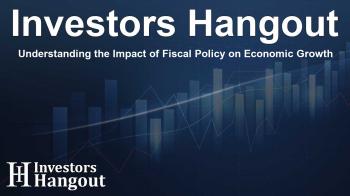Understanding the Impact of Fiscal Policy on Economic Growth

The Historical Context of Economic Growth
By the turn of the 1980s, economic growth in the United States was showing signs of change. The rolling 10-year and 20-year real GDP growth rates averaged 3.2% and 3.5% respectively. The latter part of the Reagan years saw these figures bump slightly to 3.5% and 3.6% by 1988, influenced by Reaganomics, which included tax cuts and deregulation. However, the overarching trend was largely consistent with the pre-1981 economic landscape dominated by Keynesian policies.
The Stagnation of Growth Rates
Despite the optimism that characterized the decade following Reaganomics, by 1989, the effects seemed muted, with the 10-year moving average dropping to 3.1%. Comparatively, the economic metrics between the Keynesian and supply-side approaches demonstrated a disheartening similarity. The contrast between the expected prosperity and actual performance underscored growing concerns about long-term economic planning and its consequences for future generations.
The Return to Surpluses and Fiscal Discipline
The 1990s brought about significant shifts in fiscal policies, marked by budget surpluses in the government. These surpluses, thanks to the fiscal restraint exhibited by administrations in the years that followed, were significant, yet the real median family income growth only mildly improved—advancing from $69,700 to $84,600, representing a mere 1.0% annual increase. Such progress seems limited against the backdrop of soaring federal budget deficits and monetary stimulus that would arrive in the following years.
The Effects of Modern Monetary Policies
As we look toward the future, the long-range prospects for economic growth appear less than favorable. By 2024, the crucial 20-year moving average of GDP growth had slipped to just 2.0%. This stark decline compared to past records could be attributed to systemic issues left behind from the Reagan era, including monetary policies that some view as overly aggressive and detrimental to long-term fiscal health.
Impact of Inflation and Deficits
Despite expansive fiscal and monetary stimulus measures, real median family income growth has stalled since 2000, suggesting the effectiveness of such strategies may be diminishing. A current federal spending rate of 23.2% of GDP contrasted sharply with tax revenues at a historic low of 17.0%, resulting in a persistent fiscal gap of 6.2%.
The Challenges Ahead
With interest rates set to rise, the challenge of managing a $40 trillion public debt becomes increasingly daunting. Critics assert that both political parties have failed to address the pressing need for fiscal responsibility, making necessary cuts nearly impossible due to their prior commitments to various social programs.
Future Considerations for Policymakers
The economic implications of these deficits are significant, and as planners assess future budgets, the goal of balancing the budget must contend with rising service costs on federal debt. Herein lies a challenging paradox; as debt rises, attempts to stimulate further growth could lead to greater fiscal strain without tangible benefits for middle-income families.
Conclusion
In conclusion, the interplay between fiscal policy and economic growth reflects a complicated landscape that continues to evolve. While understanding the lessons of the past is crucial, policymakers must navigate the realities of current economic challenges in a pragmatic way moving forward.
Frequently Asked Questions
What is the impact of fiscal policy on economic growth?
Fiscal policy can directly influence economic growth by adjusting tax rates and government spending, but the effects aren't always aligned with expectations.
How did Reaganomics affect the economy?
Reaganomics introduced tax cuts and deregulation, which temporarily boosted growth but did not fundamentally alter long-term growth trends.
What is the current state of the U.S. economy?
The U.S. economy is dealing with high inflation and a growing fiscal deficit, impacting growth rates and family incomes.
Why is median family income growth important?
Median family income growth reflects the economic wellbeing of average households and is a critical indicator of economic health.
What challenges do policymakers face today?
Policymakers must balance spending cuts with the need for economic growth, facing complications from existing high levels of public debt.
About The Author
Contact Owen Jenkins privately here. Or send an email with ATTN: Owen Jenkins as the subject to contact@investorshangout.com.
About Investors Hangout
Investors Hangout is a leading online stock forum for financial discussion and learning, offering a wide range of free tools and resources. It draws in traders of all levels, who exchange market knowledge, investigate trading tactics, and keep an eye on industry developments in real time. Featuring financial articles, stock message boards, quotes, charts, company profiles, and live news updates. Through cooperative learning and a wealth of informational resources, it helps users from novices creating their first portfolios to experts honing their techniques. Join Investors Hangout today: https://investorshangout.com/
The content of this article is based on factual, publicly available information and does not represent legal, financial, or investment advice. Investors Hangout does not offer financial advice, and the author is not a licensed financial advisor. Consult a qualified advisor before making any financial or investment decisions based on this article. This article should not be considered advice to purchase, sell, or hold any securities or other investments. If any of the material provided here is inaccurate, please contact us for corrections.

